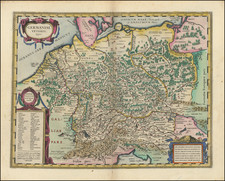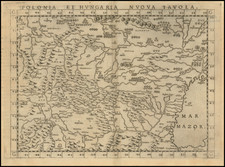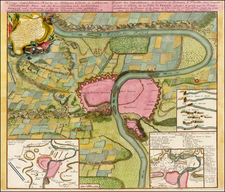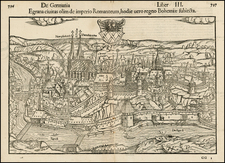Decorative family tree showing Bohemian Royal geneology, with the City of Prague in the background and portrait of Holy Roman Emperor Rudolph II (1552-1612).
The genealogical chart illustrates the lineage of the Bohemian monarchy, dating back to the late 9th century. The chart begins with Borivoj I, recognized as the first Christian Duke of Bohemia, and his consort Ludmilla, who were pivotal figures in the Christianization of the region. Notably, Borivoj I, named here as 'Borivoius quiprimus Christianus circa 900', was baptized around 874, marking a fundamental shift in Bohemian society and religion.
Significant among the successors is Saint Wenceslaus I, denoted as 'S. Wenceslaus Dux Bohemiae', the patron saint of the Czech people, whose reign ended in martyrdom at the hands of his brother in 935, not 938 as often cited. His inclusion signifies not only his historical role but also the sanctification of the royal lineage through martyrdom and piety.
Vladislaus and Dragomira appear as well, with Dragomira being labeled 'impia', likely reflecting the chroniclers' disapproval of her pagan sympathies, in contrast to the Christian virtues extolled by the earlier figures. These annotations provide a lens into the moral and religious judgments of the era.
The genealogy progresses through the centuries, chronicling the unions and descents that define Bohemian history, culminating with the portrait of Rudolph II, the Holy Roman Emperor. Rudolph II is celebrated as the 'Imperator rex hungarie et bohemiae', underscoring his sovereignty over not only Bohemia but also Hungary, indicating the expansive reach of Habsburg influence.
The presence of Dambor, identified as 'Dambovuca uxor Miecislai Ducis Poloniae primi Christiani 965', indicates the regional alliances that extended beyond Bohemia, tying the kingdom to the broader narrative of Christianization and state formation in Eastern Europe.
The chart is rich with visual and textual symbolism that elucidates the complex web of lineage, alliance, and patronage that shaped the history of Bohemia. The portraits serve as visual affirmations of the regal presence, each face gazing across time, establishing an unbroken continuity of rule and reinforcing the legitimacy of the incumbent, Rudolph II.










![[ Tribal Germany ] Germania Antiqua in IV magnos populaos in minores et minimos distincta et Regiones Danubium…1785](https://storage.googleapis.com/raremaps/img/small/97958.jpg)



![[Nové Zámky / Érsekújvár, Slovakia] La famosissima Piazza di Neuhausel nelli Confini di Ungaria assediata da Turchi li 13 Agosto 1663](https://storage.googleapis.com/raremaps/img/small/75781.jpg)